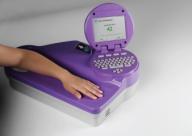|
|
|
| Diagnostics | |
Non-invasive diabetes detector unveiled2 July 2007 Chicago, USA. VeraLight Inc. has introduced an experimental device that uses light-induced fluorescence to detect diabetes-related biomarkers found in skin. Called the Scout DS, the device weighs about 10 pounds and does not require the patient to fast or provide a blood sample. Using light directed onto a small area of an individual's forearm the device is able to detect abnormal concentrations of advanced glycation endproducts (AGEs), which correlate well with diabetes and pre-diabetes and are associated with the disease's serious complications.
The company reports that previous studies of a prototype of the portable desktop system have shown that it outperforms both the fasting plasma glucose (FPG) test and the A1C test as a rapid and non-invasive screen for pre-diabetes and type 2 diabetes. The device, which is not yet approved for use in the United States, is being designed for use at the point of care under physician supervision. The company aims to introduce it to the US market in the second half of 2008. It is currently undergoing a large-scale trial in the United States. "Considering its excellent speed, convenience and sensitivity, the Scout DS may be ideally suited to detect the more than 70 million individuals worldwide who have undiagnosed type 2 diabetes," said Timothy J. Lyons, M.D., a clinical investigator for VeraLight who heads the endocrinology section at the Oklahoma University Health Science Center. "VeraLight's diabetes screening technology represents a critical response to the worldwide diabetes epidemic, making screening more accurate and accessible to everyone at risk for this devastating disease." Usefulness of AGEs for detecting diabetes AGEs are a sensitive metric for the cumulative
damage the body endures due to the effects of abnormally high blood sugar
and oxidative stress. AGEs harm the proteins that make up the blood vessels
and connective tissue, and are thought to be major factors in aging and
age-related chronic diseases. According to medical experts, non-invasive
skin detection of AGEs could replace the FPG test for screening people
suspected of having diabetes. The FPG requires a fasting blood sample; and the OGTT test requires fasting, ingestion of a glucose load, and multiple blood samples. Due to poor sensitivity the FPG misses up to 60% of the people, and the OGTT suffers from poor reproducibility with a Coefficient of Variation of up to 18%. These deficiencies can lead to false-negative or inconsistent results and add to the undiagnosed problem.
|
 After
the subject places the palm-side of the forearm onto the cradle of the Scout
DS, the device shines multiple wavelengths of light into the skin causing
AGEs to emit fluorescent light that is measured by the machine. The
instrument compensates for skin pigmentation so that performance is not
diminished by skin coloration. The system's software uses multivariate
statistical techniques that are applied to the spectra to obtain a diabetes
risk score. As with all diabetes screening methods, an additional test is
required to confirm diagnosis — the recommended confirmation for Scout DS is
an OGTT.
After
the subject places the palm-side of the forearm onto the cradle of the Scout
DS, the device shines multiple wavelengths of light into the skin causing
AGEs to emit fluorescent light that is measured by the machine. The
instrument compensates for skin pigmentation so that performance is not
diminished by skin coloration. The system's software uses multivariate
statistical techniques that are applied to the spectra to obtain a diabetes
risk score. As with all diabetes screening methods, an additional test is
required to confirm diagnosis — the recommended confirmation for Scout DS is
an OGTT.